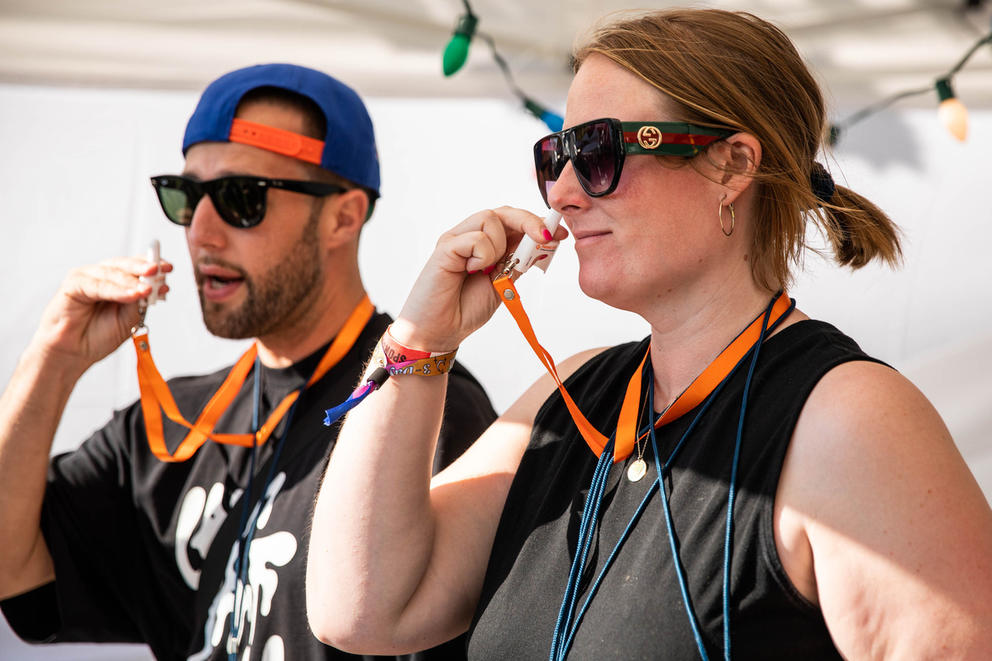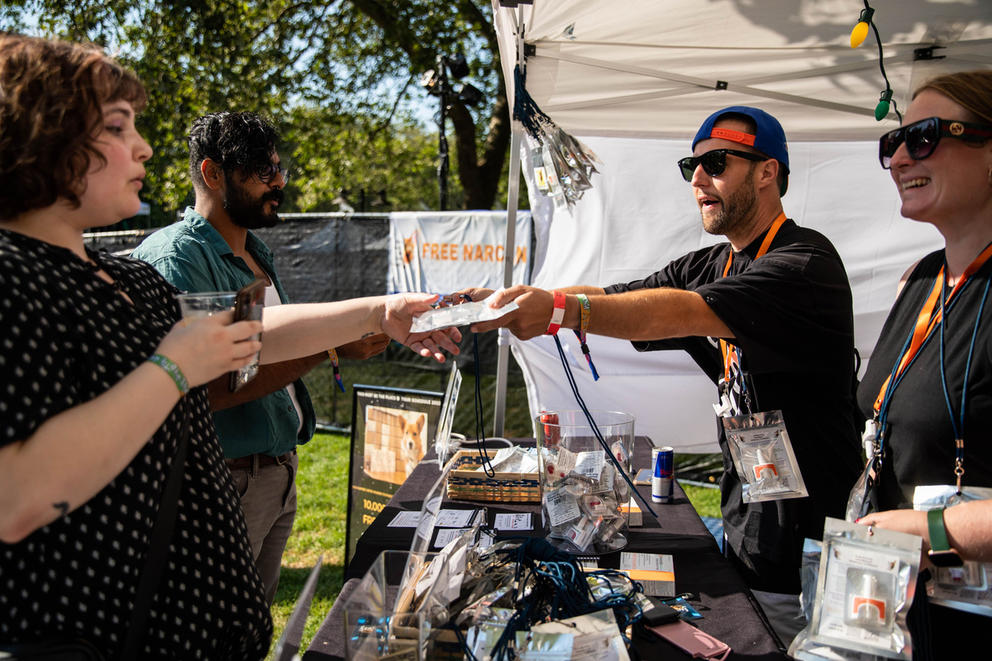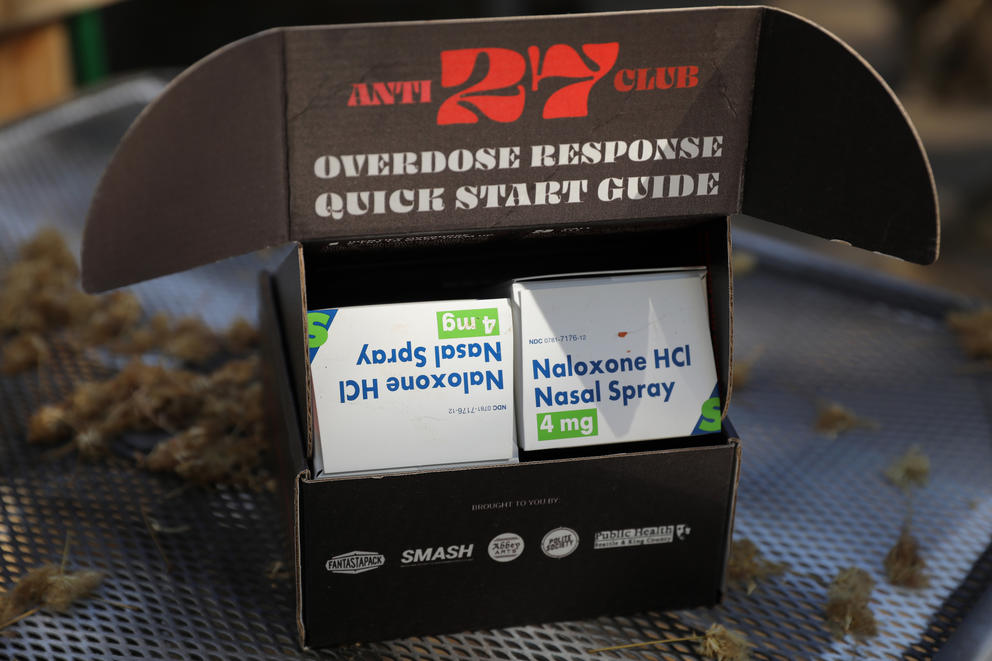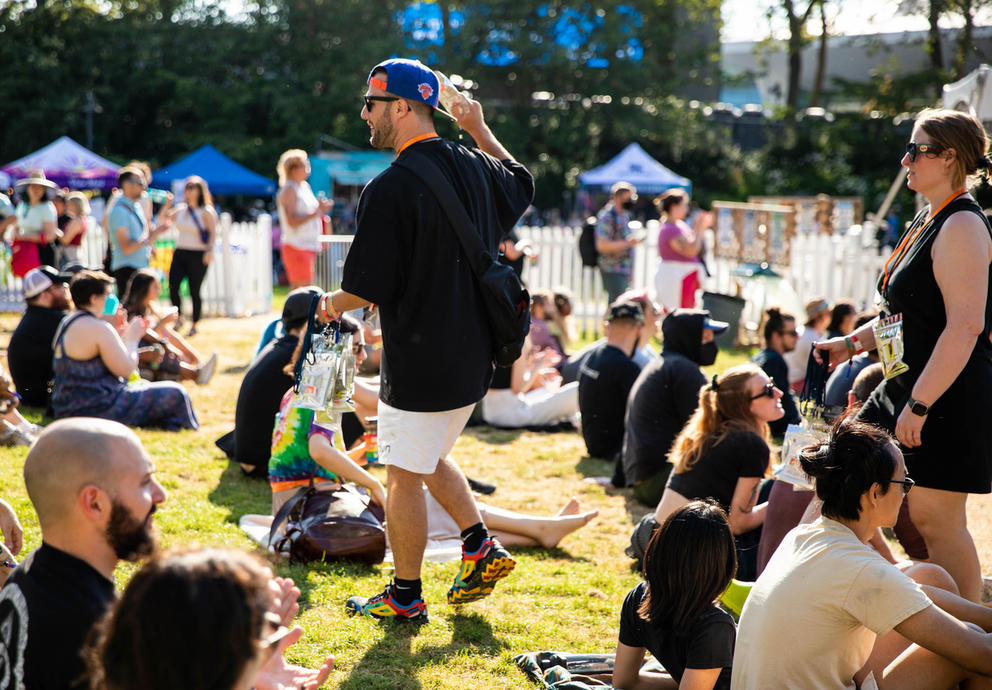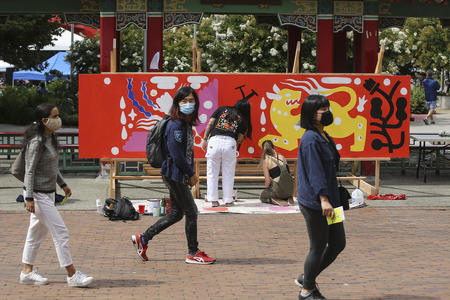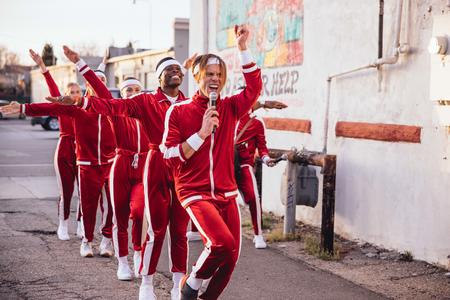Standing inside a festival booth, Ingela Travers-Hayward asks two twenty-something women approaching, “Would you like some free naloxone?” Travers-Hayward is one of the co-founders of the new Ohio-based nonprofit This Must Be The Place, which aims to “create an army of lifesavers equipped with Narcan.” And she has clearly done this hundreds of times before. She knows she only has about a minute to capture a typical festival goer’s attention, so once someone says yes, she launches into a rapid-fire spiel on how to recognize an opioid overdose.
Among the telltale signs: labored or stopped breathing, choking sounds, as well as discolored skin and fingernails. “And that’s where this stuff comes in,” Travers-Hayward says, the Space Needle towering above her. On an orange ribbon around her neck dangles what looks like the top part of an allergy spray applicator.
“It’s just a nasal spray,” Travers-Hayward continues, putting the nozzle in her nose and clicking it with two fingers. This one is a model, she adds — it contains no medication. But if you administered this to someone experiencing an overdose, “within 30 seconds to [3] minutes this will take effect,” she says. “And you may save a life.”
In response to a national surge in overdoses, This Must Be The Place is part of a growing group of so-called “harm-reduction” initiatives in the music, festival and nightlife sector that aim to educate people about the dangers of fentanyl and other opioids — as well as the life-saving power of Narcan.
Last year, Portland-based Beats Overdose started handing out Narcan and fentanyl test strips on the West Coast tour of Cypress Hill and hip-hop duo Atmosphere. Around the same time, the charitable arm of guitar manufacturer Gibson launched the Training and Empowering Musicians to Prevent Overdose (TEMPO) program, which focuses on naloxone distribution for musicians, music venues and related industries (like tour bus providers, rehearsal facilities and lighting and rigging companies). And in late 2021, New York’s office of nightlife launched the “NARCAN® Behind Every Bar” campaign to encourage bar and venue owners to stock the medicine. This past May, the magazine Wired declared, “The Must-Have Gear for Going Out This Summer? Narcan!”
The effort is building in Seattle, too. On Aug. 4, as part of the run-up to International Overdose Awareness Day on Aug. 31 and National Recovery Month in September, local nonprofit Seattle Musicians Access to Sustainable Healthcare (SMASH) launched a harm reduction campaign geared toward the music industry, called the “Anti 27 Club.”
Named for the mythology surrounding musicians who die at age 27 after a history of substance use (Jimi Hendrix and Kurt Cobain among them), the campaign hopes to educate people, reduce the stigma around substance use and provide a pathway to addiction recovery services for those who are interested.
The initiative culminates on Aug. 31 at South Park Hall with a free Overdose Response Workshop, presented with help from Public Health - Seattle/King County, which will teach venue owners and staff (as well as other industry professionals) how to spot and respond to an opioid overdose. Each attendee will also get a kit that includes two doses of Narcan, instructions on how to administer it, posters to hang in venues and fentanyl test strips. (Fentanyl test strips can be dipped into water that contains powder or crushed pills to test for the presence of the substance in the illegal drug supply — a strategy that has proven useful in preventing overdoses.)
“This [campaign] came out of my own experience of losing folks to accidental overdose,” says Nikki Barron, communications and outreach manager for SMASH. “And from seeing the trajectory of overdose deaths rising at super alarming rates ever since the pandemic — seeing that cliff coming of how this is going to become a public health emergency,” she says. “I wanted to make sure that the music industry and artists and venues are prepared.”
Overdoses are at an all-time high. King County saw a nearly 40% increase in overdose deaths in 2021, and nationally drug overdose deaths increased by nearly 15% last year. A major driver is fentanyl, says King County public health expert Brad Finegood. Fentanyl is a synthetic opioid up to 50 times stronger than heroin and 100 times stronger than morphine that is regularly mixed with drugs like heroin, cocaine and methamphetamine or made into pills that resemble other prescription opioids.
“Pills have traditionally made their way through the bar, music and club scene, as it is easy to conceal and use,” Finegood says. He also points to an erroneous belief that pills are “safer.” And recent scientific research shows that other drugs increasingly — often unbeknownst to users — contain fentanyl, which may be deadly.
“As people come back together post-COVID, it is super important to inform people of the lethal drug supply and provide life-saving overdose prevention tools,” Finegood says.
It’s hard to gauge precisely how much the music and nightlife sector is specifically affected, but Seattle venue owners and festival organizers across the board say they have not seen an increase in overdoses, or any at all, among musicians or audience members.
But the public health issue is spreading. Overdoses are now the top cause of death for Americans ages 18 to 45. It’s a bit like an oil spill: If it’s in the water, eventually it will stick to some feathers.
Some data suggest the music festival crowd may be swimming close to those waters: Research from Australia indicates that festival attendees report high levels of “illicit drug use” (note: the study counted marijuana among the drugs) compared with the general population, and a recent survey of U.S. festivalgoers showed that 54% of respondents had taken a substance from a stranger in the crowd.
That’s partly why organizations like This Must Be The Place do outreach at festivals (including, earlier this summer, the Capitol Hill Block Party). But the rise in similar initiatives also points to shifting perceptions around harm reduction in the U.S., particularly around having Narcan on hand — a strategy increasingly recommended by local and national health agencies. (In 2019, Seattle’s Office of Economic Development launched a small program that provided 10 nightlife venues with Narcan.) And perceptions of and guidance around fentanyl test strips are changing, too.
Still, some local venue owners are hesitant to talk publicly about carrying Narcan or fentanyl test strips. They worry about a legal gray zone of liability and being seen as promoting drug use. But judging by an informal poll, many Seattle venues do stock naloxone, have recently started stocking it or are planning to stock it.
“Our top priority is always to keep those who come into our rooms safe,” said a marketing manager for a prominent local music venue, who spoke on the condition of anonymity. “As we’re all getting more information about how widely this is becoming an issue, we plan to look into it and order some Narcan so we can administer it in an emergency situation.” While they haven’t experienced any issues, they want to be ready, just in case.
Few local venues carry fentanyl test strips. These are indeed a gray zone: A representative from Washington’s Department of Health said that while it’s legal to possess the test strips, it is illegal to distribute them, referring to Washington’s law concerning drug paraphernalia. When asked, King County’s Finegood said the agency had reviewed the law and felt comfortable including fentanyl test strips in the kits they’ll hand out during the Aug. 31 workshop.
Seattle musician Chris King recently got a new tattoo, his second honoring a friend who died due to substance use. King wants to help remove the stigma around addiction. People “shouldn’t be ashamed and should speak out about it,” he says, “and know that they have people to talk to that are also going through it.” (Genna Martin/Crosscut)
Multiple venues told Crosscut they will send staff to the SMASH training on Aug. 31, including SODO nightclub Supernova and Diana Adams of Vermillion bar and gallery on Capitol Hill. While Adams does have Narcan on hand, “None of us know how to use it,” she says, regarding her staff. “I guess we could Google it. It hasn’t seemed urgent,” she says. That said, “I hear it’s getting worse, as in, almost everything has fentanyl in it now,” she says.
But harm reduction in the music and nightlife sector requires a holistic approach, Adams says. “I think the city should consider public information campaigns with a tent/booth [or mobile van] in each nightlife neighborhood at high volume times, like 9 p.m. - 3 a.m. … There really needs to be a safety hub for outreach — it can also be for monkeypox, STDs, date rape drugs.”
Ricky Graboski of the all-ages music venue and nonprofit Vera Project agrees on the holistic approach. “Harm reduction is a core tenet of all of our events and programming, so we’re working on living up to that standard as best we can,” he says. Vera Project’s youth education program Live Production Lab is launching next week with workshops that include sections on CPR, overdose intervention, general crisis prevention and more. “We're also in the process of building out additional trainings, as well as pathways for independent promoters and DIY spaces to get a hold of Narcan,” Graboski says.
Being prepared doesn’t always reflect a specific concern about patrons. Nate Dwyer, COO of Seattle Theatre Group, the company behind the Paramount, Moore and Neptune theaters, says STG has now ordered Narcan kits for all its venues — partly because of drug use in the surrounding areas.
“During COVID, when our neighborhoods were less active and our venues were not active for the public, [staff members] were closer to people experiencing homelessness and crisis. They were literally [on] our doorstep,” Dwyer says. “So what we might not experience nightly in our venues was far more obvious on our doorsteps. It’s not that we were unaware that this was happening. But, being in such close proximity on a daily basis changed our collective thinking.”
While the unhoused population is disproportionately affected when it comes to opioid overdoses, the vast majority of overdoses happen inside a home, according to the Centers for Disease Control. In King County, the majority of people dying by overdose are stably housed.
Although few and far between, sometimes overdoses do happen within venues. Another manager of a prominent local music venue, who asked to remain anonymous for fear of liability issues, relayed a recent incident.
When a man overdosed on site, his wife alerted the staff that her husband was not breathing. A security guard — able to recognize an overdose thanks to a previous medical training — started doing CPR, administered Narcan and called 911. The man came to after the medics applied another dose of Narcan (which is increasingly common). “The medics said, ‘Had you guys not given the first dose, we don't know if we would have made it here in time,’” the manager says.
After regaining consciousness, the man told staff he’d bought a pill from someone on the street — he thought it was MDMA or something similar. “He had no idea he was using an opiate,” the venue manager said. “That, for us, is the scary part. And that’s why we feel this is a newer threat.”
Back at the Day In Day Out festival, Be The Place co-founder Travers-Hayward explains that many people don’t realize just how easy it is to help someone with Narcan. “A lot of people think it’s like in Pulp Fiction,” she says, referring to the infamous adrenaline-shot scene (which is not entirely accurate but persists in the cultural memory). “You don’t need to bring someone back to life by sticking a needle in their heart,” she says.
Travers-Hayward also finds herself constantly telling people that administering Narcan won’t hurt the person — even if they’re not actually overdosing. Plus, she says, people often don’t realize that individuals who administer Narcan are protected under so-called “Good Samaritan” laws. (And no, she adds, you will not overdose if you touch someone who has been in contact with fentanyl, or if you accidentally touch the substance itself.)
“More education is necessary,” says Dwyer of STG. “I think people know what [Narcan] is. I don’t know how safe people know it is. And I definitely think people aren’t sure how safe it is for them to administer without fear of repercussions,” he says. “That is one of the reasons why, within our venues, we need more people to have gone through the training.”
Travers-Hayward and This Must Be The Place co-founder William Perry, who became a chemical dependency counselor after addiction sent him to prison for 10 years, generally instruct people that giving the dose of naloxone isn’t all you need to do in an overdose situation. They tell people to call for medical help after administering Narcan – because the recipient may need other (or more) medical attention and help with addiction recovery.
As the band Animal Collective readies to go on stage, Perry gestures to a packaged naloxone applicator before handing it to a festivalgoer. “This isn’t a replacement for medical care,” he says, “but this will save their life in the meantime.”

